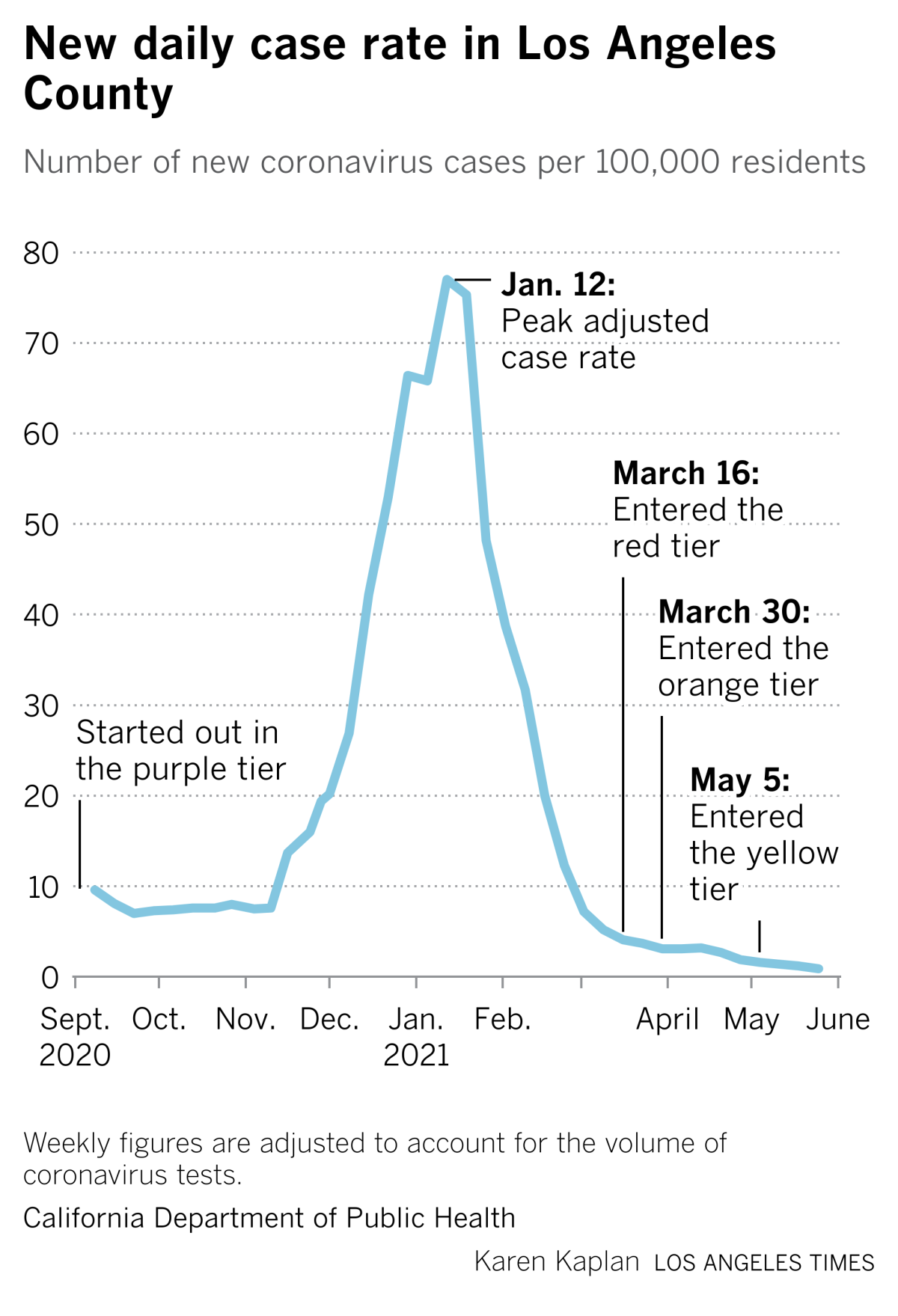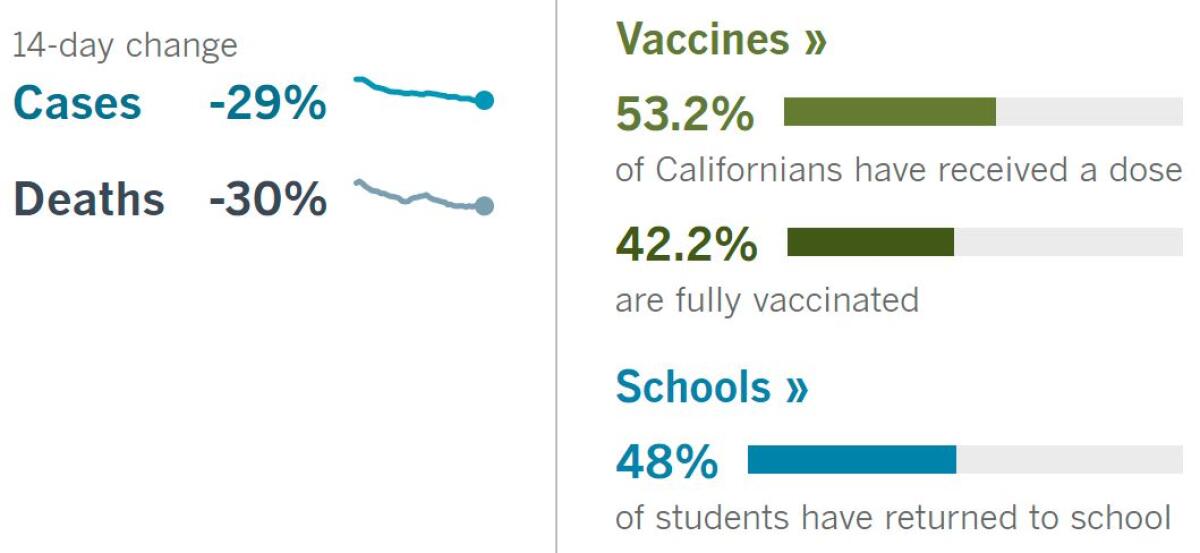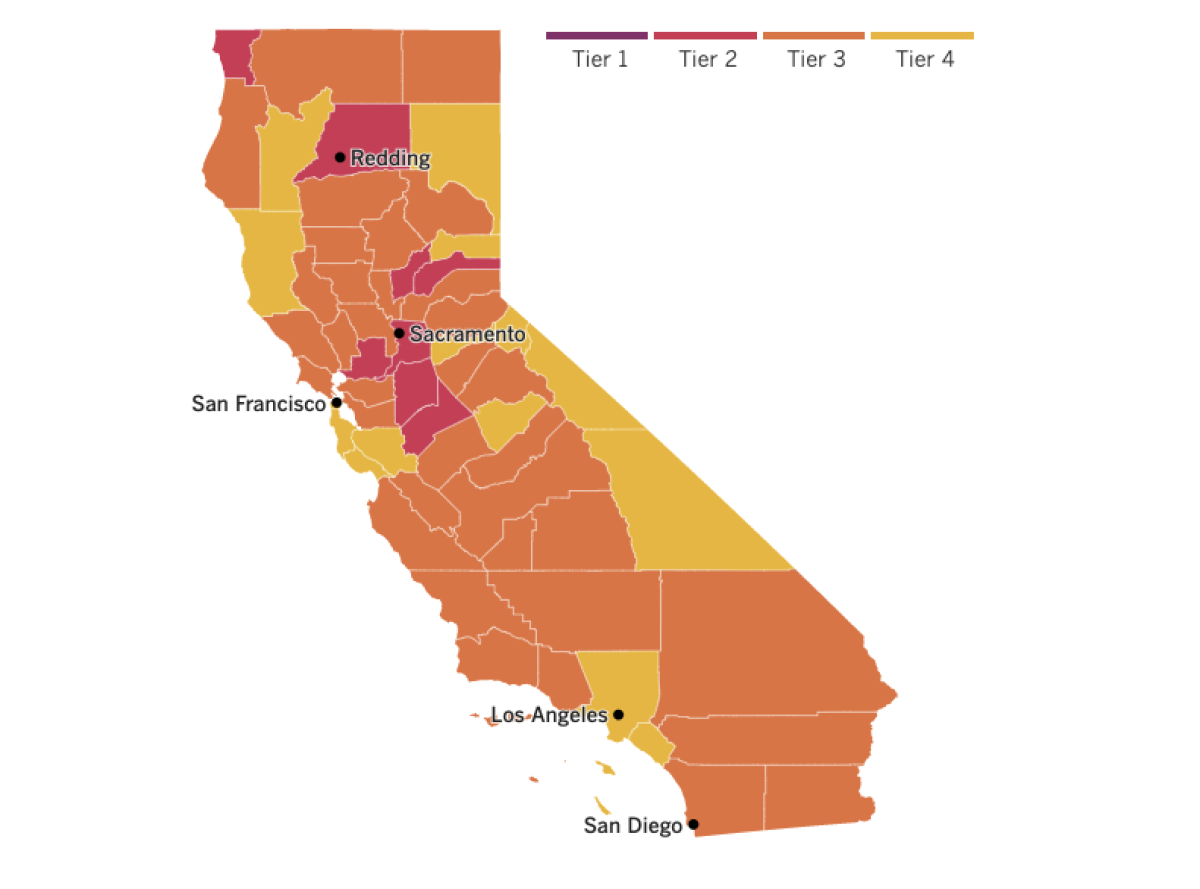Coronavirus Today: Could this number on a spreadsheet herald a return to normal?
Good evening. I’m Karen Kaplan, and it’s Tuesday, May 25. Here’s what’s happening with the coronavirus in California and beyond.
I use words for a living, but I’m a math nerd at heart. That’s one reason why I look forward to Tuesday mornings, when the California Department of Public Health updates its Blueprint Data Chart — a no-frills Excel spreadsheet containing the numbers the state uses to assign counties to their color-coded tiers based on coronavirus activity.
The first place I go is row 24, for Los Angeles County. Then I scroll over to column L, the number of new cases per day per 100,000 people, adjusted to account for the number of coronavirus tests performed.
Today, the number in the cell where this row and column meet is 0.9. That’s right — the daily new case rate is below 1.
That’s not enough to make L.A. the county with the lowest new case rate in the state. Five counties posted zeros in the adjusted case rate column: Alpine, Inyo, Mono, Sierra and Trinity.
But none of them has a population anywhere near the size of L.A.’s. We live among more than 10 million people, while the other five counties combined have fewer than 50,000.
I’ve been watching the county’s case rate since late August, when the Blueprint for a Safer Economy framework went into effect. Los Angeles started out in the most-restrictive purple tier, with 12.9 new cases per day per 100,00 residents. And we stayed there for a long, long time.

It took until mid-March for L.A. County to make it into the red tier — a huge deal in my household, since it meant my son could go back to training indoors with his gymnastics team — but once we finally got there, we had momentum. We qualified for the orange tier on March 30 and then for the least-restrictive yellow tier on May 4.
Part of my brain knows there’s not much reason to obsess over these weekly numbers anymore. There’s nothing left to shoot for now that we’re in the yellow tier, and barring a big surprise, the whole framework will go away on June 15.
Still, I take great comfort in seeing the county’s case rate continue to fall even as we open up more. I see bigger crowds in my Trader Joe’s, more people sitting inside restaurants, and fewer people wearing masks. Yet the case rate doesn’t rise — in fact, it keeps falling.
We have COVID-19 vaccines to thank for this, as well as our fellow Angelenos who gained their immunity the hard way by battling coronavirus infections on their own. (Those folks should still get vaccinated.)
I’m a worrier when it comes to the coronavirus. I spend a lot of time reading scientific studies about new coronavirus variants that spread more readily and, in some cases, are less susceptible to COVID-19 vaccines and treatments. Almost every day, I see a new report in a medical journal about a new way the virus messes with the people it infects.
But the trajectory of that graph makes me hopeful that someday soon, it really will be safe for us to go back to a pre-pandemic way of living.
By the numbers
California cases, deaths and vaccinations as of 5:40 p.m. Tuesday:

Track California’s coronavirus spread and vaccination efforts — including the latest numbers and how they break down — with our graphics.

Across California
There are a lot of things about pre-pandemic life I miss, but driving all over the place isn’t one of them. When it’s time to start commuting again, will mass transit be a realistic option?
In L.A., Metro sure hopes so, my colleagues Hayley Smith and Lila Seidman report. The agency has been busy during the pandemic building a subway under Wilshire Boulevard, extending a light rail route in the San Gabriel Valley, installing dedicated bus lanes and addressing airport construction. The work was easier while ridership was down and fewer drivers were on the roads.
The big question now is whether riders will return as the economy reopens — and how quickly. Before the pandemic, Metro was struggling to lure more riders onto its buses and trains, with several years of declining ridership. Even in New York City, one of the nation’s most transit-oriented cities, ridership is still off by about 50%.
Metro officials believe SoCal riders will come back — and that the bigger network of rail lines will make ditching the car a more viable option for others.
Juan Matute, deputy director of the UCLA Institute of Transportation Studies, said some transit routes will have something going for them that they’ve lacked in the past: a time advantage.
Federal Transit Administration Deputy Administrator Nuria Fernandez also noted that the new construction will give people greater access to jobs, education and medical services. Disparities like those have been pushed front and center by the pandemic.
“That is what public transportation does — it is the greatest equalizer and the best connector,” she said.
Perhaps you’ll take Metro to Pasadena on the Fourth of July. The city’s historic Rose Bowl stadium will resume its annual fireworks show this summer after having to move its celebration online last year thanks to the pandemic.
Details are still being worked out, but AmericaFest will have a crowd of some sort. A free event will be held outside the stadium on the lawn area beginning in the early afternoon, and a ticketed event will be held inside the stadium with live entertainment and activities. The fireworks show will begin around 9 p.m.
In other California news, the state’s health and safety agency is proposing nearly $300,000 in fines in the wake of deadly COVID-19 outbreaks at poultry processing plants operated by Foster Farms in the Central Valley.
The fines relate to the company’s Livingston facility in Merced County, where nine workers died last year. County health officials in August ordered the Livingston facility closed temporarily, citing an outbreak that had persisted for at least two months and a failure to complete widespread coronavirus testing of workers. Three other people who worked at the Cherry Avenue plant in Fresno also died.


See the latest on California’s coronavirus closures and reopenings, and the metrics that inform them, with our tracker.
Consider subscribing to the Los Angeles Times
Your support helps us deliver the news that matters most. Become a subscriber.
Around the nation and the world
The good news about vaccines keeps coming. Moderna said Tuesday that its two-dose COVID-19 vaccine strongly protects children as young as 12.
If the data check out with U.S. regulators, the Moderna shots could soon become the second option for young adolescents in the U.S. The company said it would submit its new data to the Food and Drug Administration and other global regulators in early June.
Moderna tested its vaccine in more than 3,700 people ages 12 to 17 and found it triggered the same signs of immune protection in them as it did in adults, the company said. Also similar were the temporary side effects experienced by those who got the vaccine, including sore arms, headache and fatigue.
None of the adolescents who got two doses of the vaccine were diagnosed with COVID-19, compared with four cases among those who got the placebo. The company also reported that its vaccine appeared to be 93% effective two weeks after the first dose.
The vaccine made by Pfizer and BioNTech is already authorized for use in kids ages 12 and older.
COVID-19 vaccines are performing so well that the Centers for Disease Control and Prevention now says people who are fully vaccinated can largely skip getting tested for coronavirus infections.
The agency’s new guidance says that people who have received the full course of shots and have no COVID-19 symptoms don’t need to be screened for the virus, even if they were exposed to someone who was infected.
The change was was announced last week but was largely overshadowed by the focus on the CDC’s new guidelines on masks.
The agency’s testing guidance represents a new phase in the outbreak after nearly a year in which coronavirus tests were were regarded as the primary weapon against the virus. Vaccines have taken over that role.
While it is still possible for vaccinated people to catch the virus, they face little risk of serious illness from it. And positive test results can lead to what many experts now say are unnecessary worry and interruptions at work, home and school, such as quarantines and shutdowns.
“At this point we really should be asking ourselves whether the benefits of testing outweigh the costs — which are lots of disruptions, lots of confusion and very little clinical or public health benefit,” said A. David Paltiel of Yale’s School of Public Health, who championed widespread testing at colleges last year.
In Japan, only 2% of the population is fully vaccinated, and the country is currently battling a fourth wave of COVID-19 cases and deaths. That surge has soured the Japanese public on the Summer Olympics, which are scheduled to start in Tokyo in just two months, my colleagues Hanako Lowry and Victoria Kim report.
The Tokyo Games were supposed to be a powerful sign that Japan had recovered from the devastating earthquake and tsunami that killed nearly 20,000 people in 2011. After being delayed a year, the rescheduled Games have been held up as the world’s triumph over the virus.
But in recent polls, more than 80% of Japanese residents said they want the Games postponed again or canceled altogether. Organizations representing doctors and nurses say the country’s hospitals can’t handle another increase in COVID-19 cases sparked by visitors from around the world. Dozens of towns have scrapped plans to host training camps or other Olympic-related events.
Takahiro Katsumi is particularly nervous. The 48-year-old translator lives in Saitama, which is scheduled to host basketball, soccer and golf events. Those are popular enough to lure lots of spectators, and if they bring the coronavirus with them, the consequences could be devastating for his wife, who is battling lung cancer.
“Why are we risking our loved ones for this?” Katsumi asked. “Why did we not say no?”
It’s not just the Japanese who are worried about the health risks posed by the Games. The CDC and the U.S. State Department have warned Americans against travel to Japan because of the latest COVID-19 spread.
“Because of the current situation in Japan even fully vaccinated travelers may be at risk for getting and spreading COVID-19 variants and should avoid all travel to Japan,” the CDC said.
The State Department’s warning was more blunt: “Do not travel to Japan due to COVID-19.”
The twin alerts don’t ban U.S. citizens from visiting the country, but they could have an impact on insurance rates for travelers and may factor into decisions by Olympic athletes on whether to compete.
The United States Olympic and Paralympic Committee said it still anticipates that American athletes will be able to compete safely.
Your questions answered
Today’s question comes from readers who want to know: What are my chances of getting COVID-19 if I’m fully vaccinated?
Extremely low — as in, less than 0.01%, according to a study published Tuesday by the CDC.
Researchers tallied reports of “breakthrough” coronavirus infections among people who received two doses of the Moderna or Pfizer-BioNTech vaccines or a single dose of the Johnson & Johnson vaccine. They identified 10,262 cases between Jan. 1 and April 30. By the end of the study period, 107,496,325 people in the U.S. had been fully vaccinated.
The CDC researchers acknowledged that their tally is likely a “substantial undercount.” Many people who became infected despite getting vaccinated probably experienced mild illness at worst and didn’t seek out testing to confirm the cause.
The study also reported that 995 people who had received all their recommended doses were known to have been admitted to a hospital. But not all of them went there because of COVID-19 — in fact, 29% had no COVID-19 symptoms and were admitted for other reasons.
In all, 160 fully vaccinated people with a breakthrough infection died during the study period. That’s 2% of those with breakthrough infections, and 0.0001% of U.S. residents who were fully vaccinated by April 30. All 160 people were between the ages of 71 and 89.
If the study were a report card for COVID-19 vaccines, the results would be the equivalent of “an A, if not an A-plus,” said Dr. William Schaffner, an infectious-diseases expert at Vanderbilt University. “It shows that infections among vaccinated people are, first of all, unusual. And second, that there are very few among these infections that are linked to deaths.”
We want to hear from you. Email us your coronavirus questions, and we’ll do our best to answer them. Wondering if your question’s already been answered? Check out our archive here.
Resources
Need a vaccine? Sign up for email updates, and make an appointment where you live: City of Los Angeles | Los Angeles County | Kern County | Orange County | Riverside County | San Bernardino County | San Diego County | San Luis Obispo County | Santa Barbara County | Ventura County
Need more vaccine help? Talk to your healthcare provider. Call the state’s COVID-19 hotline at (833) 422-4255. And consult our county-by-county guides to getting vaccinated.
Practice social distancing using these tips, and wear a mask or two.
Watch for symptoms such as fever, cough, shortness of breath, chills, shaking with chills, muscle pain, headache, sore throat and loss of taste or smell. Here’s what to look for and when.
Need to get tested? Here’s where you can in L.A. County and around California.
Americans are hurting in many ways. We have advice for helping kids cope, resources for people experiencing domestic abuse and a newsletter to help you make ends meet.
We’ve answered hundreds of readers’ questions. Explore them in our archive here.
For our most up-to-date coverage, visit our homepage and our Health section, get our breaking news alerts, and follow us on Twitter and Instagram.




